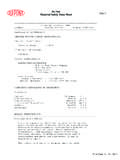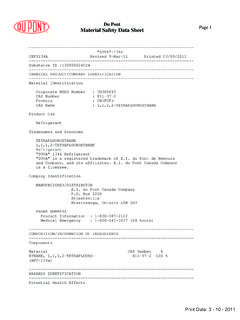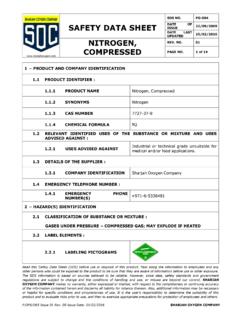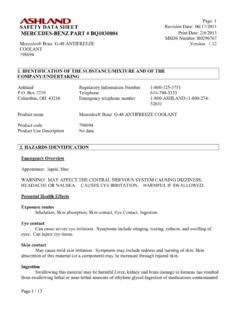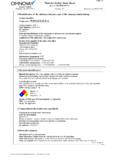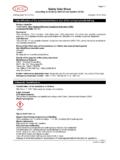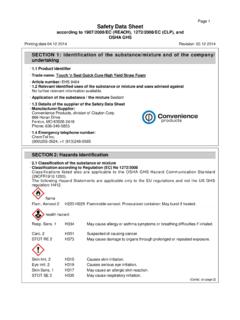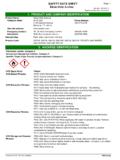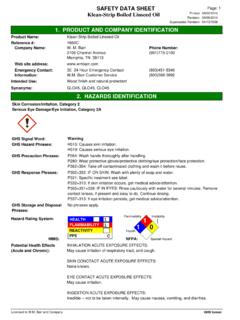Transcription of MATERIAL SAFETY DATA SHEET Page 1 of 5 - …
1 MATERIAL SAFETY data SHEET Page 1 of 5. SECTION 1 - PRODUCT AND COMPANY IDENTIFICATION. PRODUCT NAME: All Purpose PRODUCT NUMBER: DAC 104 DATE: November 7, 2011. TRADE NAME: All Purpose GENERAL USE: Foam Cleaner CHEMICAL FAMILY: Mixture PRODUCT DESCRIPTION: White cloudy or watery foaming stream as dispensed from aerosol can. Characteristic odor. MANUFACTURER. DAC Industries, Inc. APPROVED. TELEPHONE NUMBER (General Inquiries) DATE PREPARED: November 7, 2011. (651) 748-1750 SUPERSEDES: March 10, 2010. ADDRESS (NUMBER, STREET, BOX) CHEMTEL 24-HOUR EMERGENCY TELEPHONE NUMBERS. 1636 Gervais Avenue Suite 9 1-800-255-3924 813-248-0585. (CITY, STATE AND ZIP CODE) COUNTRY North America International Maplewood, MN 55109 USA (Toll Free) and Local Calls SECTION 2 - HAZARDS IDENTIFICATION. EMERGENCY OVERVIEW.
2 Danger! Aerosol with flammable gas. Contents under pressure. May be harmful if absorbed through the skin. Breathing vapors or mists may cause drowsiness and dizziness. Serious irritant to eyes; irritant to skin. Product propellant gas may collect in any confined space and may reach concentrations presenting a SAFETY hazard (health or fire) and then may be ignited by pilot lights, other flames, sparks, heaters electric motors, static discharge or other sources of ignition. Do not heat, puncture or incinerate can. Do not store at temperatures exceeding 120 F(49 C). US / TRANSPORT HAZARD SYMBOL(S) CANADA (WHMIS). HMIS HAZARD RATINGS. HEALTH: 1. 0 = INSIGNIFICANT , 1 = SLIGHT. 2 = MODERATE , 3 = HIGH , 4 = EXTREME FLAMMABILITY: 4. PHYSICAL HAZARD: 0. REQUIRED PERSONAL PROTECTIVE EQUIPMENT: HMIS PERSONAL PROTECTIVE EQUIPMENT LETTER: SAFETY Glasses, Gloves.
3 B. POTENTIAL HEALTH EFFECTS. INHALATION: High concentrations of vapors or mists may cause irritation of the respiratory tract, with coughing and wheezing. Inhalation of vapor/mists may produce narcotic effects and feeling of euphoria. Prolonged overexposure can cause rapid breathing, headache, dizziness, narcosis, or unconsciousness, depending upon concentration and period of exposure. SKIN: Causes irritation with itching, and redness, especially with prolonged contact. Absorbed through the skin. EYES: Direct contact with the liquid or exposure to vapors or mists may cause moderate to severe stinging, tearing and redness. INGESTION: May cause gastrointestinal irritation with nausea, vomiting and diarrhea. Aspiration of liquid MATERIAL into the lungs may cause [pulmonary edema, which may require immediate medical assistance.]
4 May cause central nervous system depression. Organs affected include lungs, liver, kidney, bladder, nervous system, hematopoietic system. CARCINOGENICITY: IARC MONOGRAPHS? NO NTP LISTED? NO. CALIFORNIA, NO OSHA REGULATED? NO. MATERIAL SAFETY data SHEET Page 2 of 5. PRODUCT NAME: All Purpose PRODUCT NUMBER: DAC 104 DATE: November 7, 2011. SECTION 3 - HAZARDOUS INGREDIENTS. Hazardous Components % (by Weight) CAS #. Water >60 7732-18-5. 2-Butoxyethanol (2-BE) <10 111-76-2. Liquefied Petroleum Gas <10 68476-86-8. Oleic Acid <5 112-80-1. EDTA Tetrasodium <5 64-02-8. Cocoamide DEA <5 68603-42-9. d -Limonene <5 5989-27-5. Triethanolamine <5 102-71-6. Diethanolamine <1 111-42-2. NOTES: This MATERIAL SAFETY data SHEET is prepared to comply with the United States Occupational SAFETY and Health Administration (OSHA) Hazard Communication Standard (29 CFR ) and the Canadian Workplace Hazardous Materials Information System (WHMIS).
5 Hazard symbols and risk phrases are based on maximum listed concentration of each hazardous ingredient. Unlisted ingredients are not "hazardous" per the OSHA Hazard Communication Standard or the Canadian Workplace Hazardous Materials Information System and are considered trade secrets. SECTION 4 - FIRST AID MEASURES. INHALATION: Remove to fresh air, apply artificial respiration if breathing has stopped. Consult a physician immediately. EYES: Remove contact lenses. Flush eyes well with clean potable water for at least 15 minutes. Consult a physician if irritation persists. SKIN: In case of contact, flush skin with plenty of water. Remove contaminated clothing and shoes. Get medical aid if irritation develops and persists. Wash clothing before reuse. INGESTION: Unlikely route of exposure.
6 Do not induce vomiting; give 1 or 2 glasses of water to drink. Consult a physician or poison control center immediately. Treatment is dependent on amount ingested and the condition of the patient. SECTION 5 - FIRE FIGHTING MEASURES. GENERAL HAZARDS: Aerosol propellant is extremely flammable! Flash Point -156 F estimate. Gas may cause a flash fire or ignite explosively. Gas may travel a considerable distance to a source of ignition and flash back. Level 3 Aerosol. EXTINGUISHING MEDIA: Carbon dioxide, dry chemical, fine water spray. FIRE FIGHTING PROCEDURES: Firefighters must wear full facepiece self - contained breathing apparatus in positive pressure mode in enclosed areas. Fine water spray can be used to keep fire - exposed containers cool. UNUSUAL FIRE AND EXPLOSION HAZARDS: Closed containers can explode due to buildup of pressure when exposed to extreme heat.
7 Caution - Propellant is extremely flammable! Avoid possible bursting of aerosol can. Do not store where temperatures exceed 120 F (49 C). Do not puncture or incinerate. HAZARDOUS COMBUSTION PRODUCTS: Incomplete combustion may produce Carbon Monoxide, and Carbon Dioxide. SECTION 6 - ACCIDENTAL RELEASE MEASURES. STEPS TO BE TAKEN IN CASE MATERIAL IS RELEASED OR SPILLED: Eliminate all sources of ignition from area; ventilate area. Remove with absorbent MATERIAL or flush or vacuum into a safe container. Dike large spills. Do Not Flush This Product To Sewers or Other Watercourses. SECTION 7 - HANDLING AND STORAGE. PRECAUTIONS TO BE TAKEN IN HANDLING AND STORAGE: Do not store at temperatures above 120 F (49 C). Store away from fire, sparks , flame or other sources of ignition. Store in a cool dry place.
8 Do not smoke while using this product. Do not spray in direction of body. Use only in accordance with directions. MATERIAL SAFETY data SHEET Page 3 of 5. PRODUCT NAME: All Purpose PRODUCT NUMBER: DAC 104 DATE: November 7, 2011. SECTION 8 - EXPOSURE CONTROLS / PERSONAL PROTECTION. NIOSH ACGIH OSHA. HAZARDOUS COMPONENTS. TWA ppm TWA mg/m3 STEL ppm STEL mg/m3 TLV/TWA ppm TWA mg/m3 PEL ppm PEL mg/m3. Water NE NE NE NE NE NE NE NE. 2-Butoxyethanol (2-BE) 5 24 NE NE 20 NE 50 240. Liquefied Petroleum Gas 1000 1800 NR NR 1000 NR 1000 1800. Oleic Acid NE NE NE NE NE NE NE NE. EDTA Tetrasodium NE NE NE NE NE NE NE NE. Cocoamide DEA NE NE NE NE NE NE NE NE. d -Limonene NE NE NE NE NE NE NE NE. Triethanolamine NE NE NE NE NE 5 NE NE. Diethanolamine 3 15 NE NE NE 2 NE NE. PERSONAL PROTECTION.
9 RESPIRATORY PROTECTION: If TLV is exceeded wear a NIOSH approved vapor respirator suitable for organic vapors removal. PROTECTIVE GLOVES: Use solvent resistant gloves (neoprene or nitrile) to protect against skin absorption of this product. EYE PROTECTION: SAFETY glasses with side shields or chemically protective splash goggles required during use. OTHER PROTECTIVE CLOTHING OR EQUIPMENT: Provide adequate area ventilation using explosion proof ventilation equipment to keep airborne concentrations low. WORK / HYGIENIC PRACTICES: Observe standard industrial hygiene practices during use, do not eat, drink, smoke during use. Wash hands with soap and water before eating drinking or smoking. Wash contaminated clothing before re-use. SECTION 9 - PHYSICAL AND CHEMICAL PROPERTIES. APPEARANCE AND ODOR VAPOR PRESSURE.
10 Clear to brown mist as dispensed from aerosol can. Slight odor. >Air pH SPECIFIC GRAVITY (WATER = 1). NR < Boiling Range SOLUBILITY IN WATER. Not Known Negligible FLASH POINT VISCOSITY. -156 F estimated for propellant NR. FLAMMABLE LIMITS VAPOR DENSITY (AIR = 1). LEL: NE UEL: NE > AUTOIGNITION TEMPERATURE EVAPORATION RATE (WATER = 1). NR > VOLATILE ORGANIC COMPOUND (VOC) INFORMATION. >90% Estimated SECTION 10 - STABILITY AND REACTIVITY. STABILITY STABLE X CONDITIONS TO AVOID: Product is stable under normal conditions of use. Do not use near heat, sparks, open flames or other sources of ignition. INCOMPATIBILITY (MATERIALS TO AVOID): Avoid contact with strong oxidizers and reducing agents HAZARDOUS DECOMPOSITION OR BYPRODUCTS: Carbon Monoxide, Carbon Dioxide. HAZARDOUS POLYMERIZATION: CONDITIONS TO AVOID: Will not occur.

